How long does it take to grow cannabis?
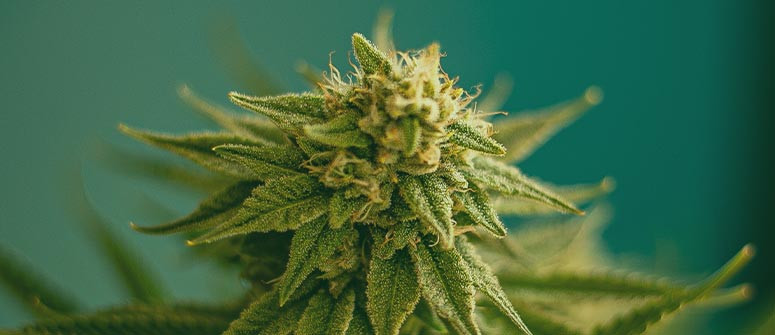
Growing weed always requires some patience, but some plants take much longer than others, whether due to genetics or environmental factors. Here we look at specific factors that affect the growing time of cannabis, and determine about how long you can expect to wait, from seed to smoke.
Contents:
Growing weed, even with the fastest strains, takes a relatively long time. You’ve got to germinate the seeds, see them through the seedling phase, and then wait out the veg phase until the flowers finally start appearing. At this point, it’s a long wait until they're ready to harvest, and it’s not even over then!
In what follows, we break down the different stages of growing, harvesting, drying and curing weed to give you some indication of how long the entire process takes, from start to finish.
How long does cannabis take to mature?
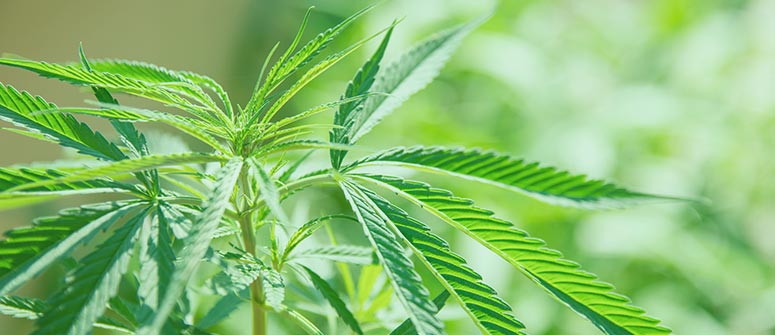
Much like people, different cannabis plants take a different amount of time to mature. Mostly, this is affected by the plant’s genetics. However, environmental factors can play a role too.
With photoperiod plants, the indoor grower decides how long they stay in the vegetative stage (though usually it’s around 4–6 weeks). And then, on average, the flowering stage takes around 10 weeks. So, as a very rough guide, we can say that a photoperiod plant grown indoors will probably take around 16 weeks from germination to harvest.
Outdoors, photoperiod marijuana plants follow the seasons, and reach harvest time toward the end of September (early) to the end of October (late) in the Northern Hemisphere.
Autoflowering plants, on the other hand, take between 8 and 12 weeks (usually) to complete their entire life cycle, regardless of whether they are grown indoors or out.
The main factors impacting the grow time of cannabis
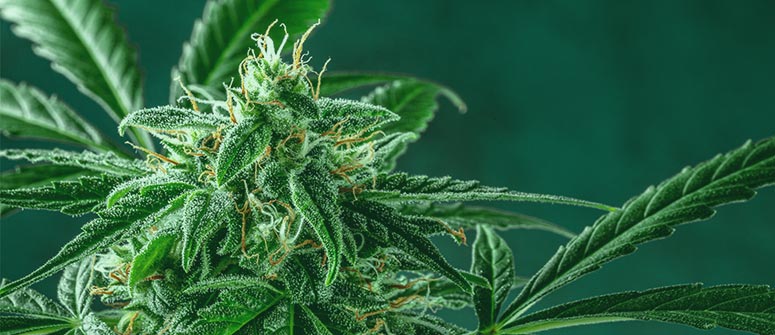
The two main factors that affect overall grow time are genetics and environment. Let’s break it down a little.
Genetics
Each cannabis genotype comes with a predetermined flowering period. Some are very fast, completing their bloom stage in as little as 49 days. Others, like some pure sativa strains, can take twice this amount of time. In terms of vegetative growth, photoperiod cannabis plants will remain in the veg stage for as long as the indoor grower deems necessary. So, for the most part, there is no genetic predisposition to veg for an exact period.
Autoflowering cannabis, though, has an internal clock that runs from germination through to death, and can’t be changed. The ruderalis genes in autoflowering cannabis strains are set to begin flowering after a set amount of time—usually 3–4 weeks. As a consequence, it is very easy to estimate when an autoflowering plant will be ready to harvest, so long as you know are familiar with the specific cultivar.
Environment
The environment in which you grow your crop will also determine how long a marijuana plant takes to mature.
When growing indoors, you have much more control. You decide when a plant enters the flowering stage, and then it will take a set amount of time from that point before it’s mature. Therefore, as long as you have a plan, you’ll know, roughly, when it will be finished from the beginning.
When growing outdoors, however, things are a little different. Under the sun, weed plants follow the cues of seasonal changes in frequency and hours of light. So a plant that has an 8-week flowering period indoors might take a slightly different amount of time to finish outdoors. Therefore, outdoor harvest estimates are based on the time of year, such as the last two weeks of September.
Likewise, cannabis grown outdoors will begin flowering when light levels shift. So regardless of whether a seed germinates in March, April, or May, it will start to bloom at the same time.
The 4 stages of cannabis plant development
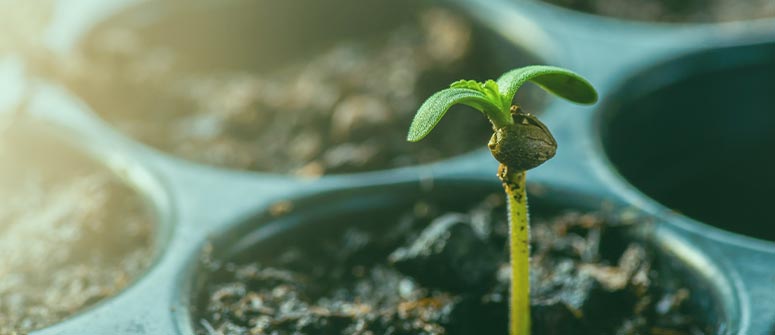
Broadly speaking, there are four stages to a cannabis plant’s life: germination, seedling stage, vegetative stage, and flowering stage.
Each of these is distinct and requires different practices. Given that, before embarking on your cannabis growing adventures, you should acquaint yourself with how cannabis grows and what it needs. Arming yourself with this knowledge before you start will put you in better stead once you’re faced with each stage!
Germination
Germinating cannabis seeds is a fine art. Although, sometimes it just works, and other times it doesn’t.
Predicting how long it will take can be difficult too. It can take as little as a couple of days, but sometimes it can take a week or even two. Largely, this process is determined by temperature and moisture content. Furthermore, the quality of the seeds can determine how early they pop, or if they do so at all. Seeds purchased from reputable seed banks have high germination rates and, given the appropriate conditions, should nearly always sprout.
Is it possible to speed up the germination process?
You can’t artificially speed up the germination process per se, but some practices tend to be faster than others.
Specifically, germinating seeds in a paper towel or a glass of water are the fastest options, especially compared to germinating directly in soil, which can take several days longer.
Seedling stage
The seedling stage lasts until a young cannabis plant has two or three true sets of leaves, not including the two rounded cotyledon leaves.
Depending on the strain, this phase lasts around one week. Regardless of genetics, growers cannot influence how long the seedling stage lasts. However, it’s a time during which you must be very careful. Plants are sensitive at this point and can easily be damaged or killed, so treat them with love!
Vegetative stage
The vegetative stage is usually the second-longest stage of a cannabis plant's life, and is very important. With photoperiod plants, as mentioned, this stage lasts as long as growers want (indoors) or until summer begins to draw to a close (outdoors).
Indoor growers usually veg their plants for anywhere from 4–8 weeks, though this depends on a few factors. Those employing high-stress training techniques, for example, will let their plants veg for slightly longer to allow them to recover from the damage. Likewise, if something happens to a plant during germination or the seedling stage, a longer veg phase might help it recover its strength.
Furthermore, space plays a large role in the length of the veg stage. An eight-week-long veg stage is bound to produce significantly more sizable plants than four weeks, so it’s important to take that into account.
Again, for autoflowering plants, the veg phase is about 3–4 weeks long, no matter what you do. This is why growers are not encouraged to use high-stress training techniques on auto plants.
Flowering stage
How long will cannabis flower for? This is an important question for any grower—and the answer varies.
The flowering period differs greatly from strain to strain. Some photoperiod indicas have a flowering period of below two months (as short as 7 weeks), whereas some photoperiod sativa plants can flower for more than three months (12–15 weeks)! Usually, 9–10 weeks is a safe best for most modern hybrid strains.
Pre-flowering stage
When cannabis plants leave the vegetative stage, they enter a brief “pre-flowering” stage. At this point, they have yet to develop true flowers, and may spend most of this time surging in height before putting all of their energy into bud production. You can tell this stage has begun when female plants begin to produce their first pistils at the nodes. From these pistils, your cannabinoid-rich flowers will eventually blossom.
Pre-flowering usually lasts between one and two weeks. During this time, plants can double in size. Following this, upward and outward growth will cease, and energy will be redirected toward flower production.
Mid-flowering stage
The mid-flowering stage takes up the bulk of the flowering period. Once the first buds appear, a plant is in “mid-flowering” until the last week or so of its life. In this stage, buds develop and produce their first trichomes, and pistils turn from white to red.
Depending on the strain, the mid-flowering stage can last anywhere from around 5–6 weeks up to around 12.
Late flowering stage
Late flowering is the very last stage of a plant's life before it is ready to be harvested. At this time, the buds are almost mature, growth has stopped, and you’re just waiting for the trichomes to turn milky white.
At this point, some growers choose to flush their growing medium with pH-balanced water, in hopes of washing all of the nutrients out of the soil, forcing the plant to use up its reserves. It is thought that doing this makes the final product taste smoother and more delicious.
What is the longest flowering time for autoflowers?
With autoflowering plants, the flowering period lasts around 4–7 weeks, regardless of whether it’s being grown indoors or out.
At its longest, the flowering period could be around eight weeks, but this is unusual.
Not there yet: harvesting, drying, and curing
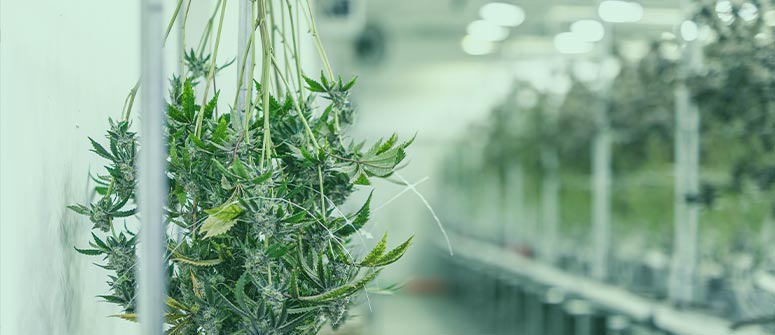
So you’ve done it; you successfully grown cannabis all the way from seed to harvest. Now it’s time to enjoy your reward… almost!
Before you can smoke the bud, you’ve got to harvest, dry, and cure it. This, sadly, takes another few weeks. But once complete, you’ll have a delicious stash of high grade at your disposal.
Harvesting
Harvesting involves cutting the flowers off the plants, and then trimming the sugar leaves. This can be done “wet”—i.e. before the buds are dried—or “dry”, before the buds are cured.
Depending on how efficient you are, and how much weed you’ve grown, this process will take different amounts of time. Usually, though, for most small home grows, it should take but a few hours.
Drying
So, how long should you hang your cannabis to dry? Drying weed usually takes between 5 and 10 days. You don’t want it to be bone dry at the end of this, as this can negatively affect the smoothness and taste. Nevertheless, you want to get most of the moisture out. You’ll know the buds are ready when the stems snap, rather than bend, under pressure.
At this point, you can technically smoke it. However, if you have a little more patience, you can get your stash tasting much better by giving it a good cure.
Curing
Curing weed ekes out the final moisture in such a way that your bud isn’t left brittle, dry, and harsh. It also helps to enhance the flavour profile of your stash. Essentially, quality curing makes quality bud.
At a minimum, curing should take two weeks, but it can take up to six. Curing involves placing buds in airtight jars, and opening, or “burping”, them once or twice a day to allow moisture out and fresh air in.
Growing cannabis: patience is key
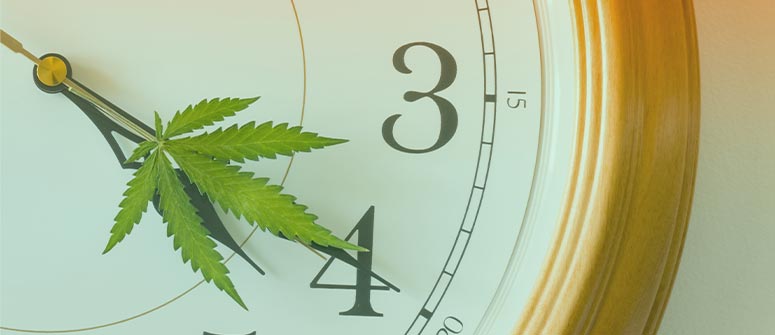
As you can see, the whole process of growing cannabis takes some time. A quick autoflower could go from germination to jar in around 10 weeks—at a push—whereas a lengthy sativa could take well over 20. That’s almost half a year. Still, if the end result is beautiful and bountiful, then it’s all worth it.
Taking into account all of these factors is important before you begin growing, as you need to know how long it will take, and whether you have the necessary patience. If you want quick results, then certainly go for a speedy auto. If you’ve got more patience, then shop around for the best cannabis seeds you can find!
.jpg)
.jpg)

.jpg)
